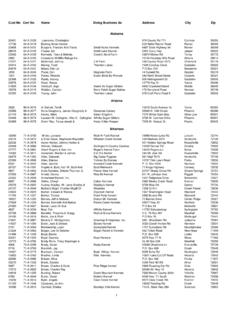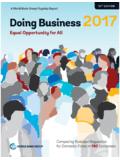Transcription of Doing aquaculture as a business for small- and …
1 Doing aquaculture as a business for small - and medium - scale farmers Practical training manual Module 1: The technical dimension of commercial aquaculture The designations employed and the presentation of material in this information product do not imply the expression of any opinion whatsoever on the part of the Food and Agriculture Organization of the United Nations (FAO) concerning the legal or development status of any country, territory, city or area or of its authorities, or concerning the delimitation of its frontiers or boundaries. The mention of specific companies or products of manufacturers, whether or not these have been patented, does not imply that these have been endorsed or recommended by FAO in preference to others of a similar nature that are not mentioned. The views expressed in this information product are those of the author(s) and do not necessarily reflect the views or policies of FAO. ISBN 978-92-5-109807-3.
2 FAO, 2017. FAO encourages the use, reproduction and dissemination of material in this information product. Except where otherwise indicated, material may be copied, downloaded and printed for private study, research and teaching purposes, or for use in non-commercial products or services, provided that appropriate acknowledgement of FAO as the source and copyright holder is given and that FAO's endorsement of users' views, products or services is not implied in any way. All requests for translation and adaptation rights, and for resale and other commercial use rights should be made via or addressed to FAO information products are available on the FAO website ( ) and can be purchased through This publication has been printed using selected products and processes so as to ensure minimal environmental impact and to promote sustainable forest management. Doing aquaculture as a business for small - and medium - scale farmers Practical training manual Module 1: The technical dimension of commercial aquaculture by Ana Menezes Fishery and aquaculture Officer FAO Subregional officer for Easter Africa Addis Ababa, Ethiopia Nathanael Hishamunda FAO Representative Port-au-Prince, Haiti Leonard Lovshin Professor Emeritus Auburn University Auburn, the United States of America and Elisabetta Martone FAO consultant Rome, Italy FOOD AND AGRICULTURE ORGANIZATION OF THE UNITED NATIONS.
3 Rome, 2017. iii Abstract The Doing aquaculture as a business for small and medium scale farmers . Practical training manual is composed of two modules: Module 1 The technical dimension of commercial aquaculture and Module 2 The economic dimension of commercial aquaculture . The target users of both modules are trainers, educators, extension officers as long as are small and medium scale fish farmers . The purpose of this module is to enhance their knowledge and capacities in understanding and applying the basic technical principles and concepts of commercial aquaculture in their daily activities. FAO. 2017. Doing aquaculture as a business for small and medium scale farmers . Practical training manual. Module 1: The technical dimension of commercial aquaculture , by Ana Menezes, Nathanael Hishamunda, Leonard Lovshin and Elisabetta Martone. Addis Ababa, Ethiopia; Rome, Italy. v Contents Abstract iii Acknowledgements vii Abbreviations and acronyms viii Introduction 1 1 Principles of aquaculture 1 Key definitions 1 Factors influencing primary productivity in water 2 Factors influencing carrying capacity in water 10 Factors influencing the growth rate in water 19 Factors influencing yield in water 27 2 Classification of farming systems 31 3 Introduction to pond and cage culture systems 32 Pond based aquaculture 32 Cage based aquaculture 32 4 Design and construction of pond farms 33 Criteria for the site selection of a pond farm 33 Design and construction of ponds 34 Water 35 5 Seed production 36 6 Nutrition and feeds 36 7 Harvest and post harvest practices 38 References 39 Further reading 41 Boxes Box 1.
4 Factors influencing primary productivity in water 3 Box 2. Forms of nitrogen found in water 5 Box 3. How to calculate the ammonia production rate 5 Box 4. Example of lime supply 8 Box 5. Solubility of carbon dioxide, calcium bicarbonate and calcium carbonate 8 Box 6. Factors influencing carrying capacity in water 10 Box 7. How to calculate the feed conversion ratio 11 Box 8. How to calculate the average growth rate 19 Box 9. Factors influencing growth rate in water 19 Box 10. How to calculate the relative and absolute growth rate 22 Box 11. Examples of feed allotment based on fish species weight 23 Box 12. Factors influencing yield in water 27 Box 13. How to calculate the yield 29 Box 14. Advantages and disadvantages of partial harvest and restock 31 Box 15. How to calculate the draining days 34 Figures Figure 1. Total energy received from direct solar radiation at different latitudes 3 Figure 2. The influence of water temperature and pH on the percentage of un ionized ammonia 6 Figure 3.
5 Changes in the levels of NH3, NO2 and NO3 in response to bacterial oxidation 7 Figure 4. Relationship between phytoplankton productivity and total alkalinity in ponds 8 Figure 5. Effects of pH on the mole fraction of H2CO3, free CO2, HCO3 and CO32 in freshwater 9 vi Figure 6. Fluctuation of pH in low and moderate alkalinity ponds 9 Figure 7. Relationship of depth and primary production in a fertile pond 11 Figure 8. Thermal stratification 12 Figure 9. Relationship of fish weight, feeding rate and dissolved oxygen level 12 Figure 10. Calculation of dissolved oxygen 13 Figure 11. Influence of aeration on dissolved oxygen in a fed fishpond 13 Figure 12. Level of interventions 16 Figure 13. Increase in average individual fish weight between stocking (T1) and harvest (T2) 19 Figure 14. Influence of water temperature on fish growth 20 Figure 15. Influence of age on fish growth rate 20 Figure 16. Relative growth rate 22 Figure 17.
6 Absolute growth rate 22 Figure 18. Relationship of body weight to percentage of body weight fed/day 22 Figure 19. Relationship between the stocking density of 50 gram fish and growth rate at different levels of nutrient inputs 23 Figure 20. Relationship between average harvest weight and stocking density of 50 gram fish over time at one level of nutrient input 23 Figure 21. Relationship between carrying capacity and stocking density at one level of food abundance 25 Figure 22. Relationship between growth rate and stocking density of a 50 gram fish at one level of nutrient input 25 Figure 23. Relationship between growth rate and production rate 26 Figure 24. Relationship between stocking density, growth rate and production rate over time for a given fish weight 26 Figure 25. Relationship between standing crop and production rate 27 Figure 26. Relationship between fish yield and length of the growing season in tropical and temperate climates 28 Figure 27.
7 Relationship between standing crop and accumulated yield over time in a polyharvest system 30 Figure 28. Relationship between standing crop and accumulated yield over time for a partial harvest and restock system 30 Plates Plate 1. Cages with paddle wheel aerator 14 Plate 2. Raceways fry rearing 15 Plate 3. Farmed carps show food habits for each fish 18 Plate 4. Predator, carp culture 29 Plate 5. Partial harvesting of farmed carps in ponds, Bangladesh 30 Plate 6. Tilapia earthen pond farm showing gravitational water in flow, Rwanda 32 Plate 7. Tilapia cage farm on Lake Kivu, Rwanda 33 Plate 8. Layout of a typical commercially oriented small fish farm 35 Tables Table 1. Influence of aeration on the yield of channel catfish 14 Table 2. Measured aerator efficiencies 14 Table 3. Influence of common carp on the yield of male tilapia 18 Table 4. Stocking density, individual harvest weight and yield of male Nile tilapia, Honduras 24 Table 5.
8 Yield and percent of harvestable mixed sex Nile tilapia, Brazil 24 Table 6. Stocking density and growth rate influence on production rate 27 Table 7. Feeding table for tilapia using formulated feed under semi intensive pond farming 37 vii Acknowledgements The preparation of this manual benefitted greatly from funding provided to the Blue Growth Initiative (BGI) through the FAO Multipartner Programme Support Mechanism (FMM) in the context of the Support of Food Nutrition Security, Poverty Alleviation and Healthy Oceans (FMM/GLO/112/MUL Baby 04) and the FAO Africa Solidarity Trust Fund (ASTF) project, Promoting Agricultural Diversification to Reduce Poverty, Fight Malnutrition and enhance Youth Employment Opportunities in Eastern Africa (GCP/SFE/001/MUL). We would like to acknowledge the exceptional support of the FAO Assistant Director General and Regional Representative for Africa, Mr Bukar Tijani, the Assistant Director General of the FAO Fisheries and aquaculture Department, Mr rni Mathiesen, and the FAO Subregional Coordinator for Eastern Africa and Representative to AU and UNECA, Mr Patrick Kormawa, in the development of Fisheries and aquaculture programmes in Africa.
9 The effort of all colleagues from the aquaculture branch of the FAO Fisheries and aquaculture Department is greatly acknowledged. We would like to thank the FAO Representations in Burundi, Kenya, Uganda and Rwanda for their dedicated assistance and substantial technical contributions at various training workshops during which these materials were tested, resulting in this polished manual. Special thanks must be expressed to Ms Claudia Broderick (International Administrative Officer at FAO Subregional for Eastern Africa) and to Mr Yaw Ansah (Junior Professional Officer at FAO Subregional for Eastern Africa) for their support in the planning and finalization of this training manual. viii Abbreviations and acronyms ASTF Africa Solidarity Trust Fund K Potassium AU African Union K+ Ions of Potassium Al2(SO4)3 Alum K2CO3 Potassium Carbonate AlPO4 Aluminium Phosphate KHCO3 Potassium Bicarbonate BGI Blue Growth Initiative Mg Magnesium BOD Biological Oxygen Demand Mg++ Bivalent Ions of Magnesium C Carbon MgSO4 Magnesium Sulphate C6H12O2 Carbohydrates N Nitrogen Ca Calcium N2 Nitrogen Gas Ca(HCO3)2 Calcium Bicarbonate Na+ Ions of Sodium Ca++ Bivalent Ions of Calcium Na2CO3 Sodium Carbonate Ca3(PO4)2 Tricalcium Phosphate NaCl Sodium Chloride CaCl2 Calcium Chloride NH3 Unionized ammonia +.
10 CaCO3 Calcium Carbonate NH4 Ionized Ammonia CaSO4 2H2O Gypsum NO2 Nitrite CC Carrying Capacity NO3 Nitrate Cl Chlorine NY Net Yield Co Cobalt O2 Oxygen CO2 Carbon dioxide OH Hydroxide 2 . CO3 Carbonate P Phosphorous CSC Critical Standing Crop PP Primary Production Cu Copper PPR Primary Productivity DO Dissolved oxygen PR Production Rate FCR Feed Conversion Ratio PTO Power Take Off Fe Iron SAE Standard Aeration Efficiency FMM FAO Multipartner Programme SC Standing Crop Support Mechanism Se Selenium GR Growth Rate . SiO3 Silicate GY Gross Yield SO4 Sulphate H2CO3 Carbonic Acid TAN Total Ammonia Nitrogen H2O Water TP Total Production HCO3 Bicarbonate UNECA United Nations Economic I Iodine Commission for Africa Zn Zinc Introduction 1 Introduction The Doing aquaculture as a business for small and medium scale farmers . Practical training manual is composed of two modules: Module 1 The technical dimension of commercial aquaculture and Module 2 The economic dimension of commercial aquaculture .















